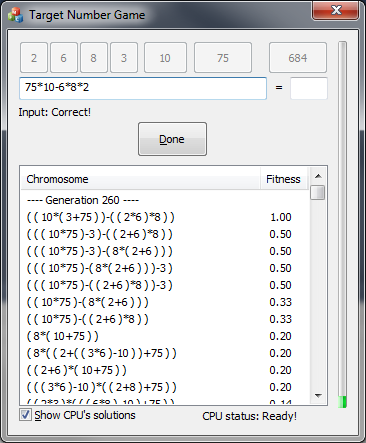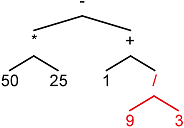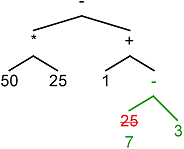
Target Number Game
In this game, the player has the task to find a mathematical expression whose value is closest to a randomly chosen value using only basic operations and a predefined set of numbers. The game has other restrictions: all intermediate results and the final result must be positive integer numbers. Additional restrictions are also placed on the selected and target numbers. The player gets four random numbers between 1 and 9, one number from the { 10, 15, 20 } set and one from the { 25, 50, 75, 100 } set. The target number is randomly chosen from the interval [100,999]. The player can use the selected numbers only once. Whoever has the expression with the closest number to the target wins, and if there is a tie, the player who was choosing the numbers wins.
Number of Possible Expressions
Before implementing the actual algorithm for solving this problem, it would be interesting to see how many expressions we can make using the selected numbers and basic operations. The number of possible expression trees for a defined number of leafs (numbers used in the expression) is defined by the Catalan number  where n should be the number of leafs minus 1.
where n should be the number of leafs minus 1.
The number of possible expressions is also governed by the number of performed operations and the number of combinations of the selected numbers. The number of combinations is defined by the binomial coefficient  where n is the count of selected numbers and k is the count of numbers that we actually use in the expression (expression tree leafs).
where n is the count of selected numbers and k is the count of numbers that we actually use in the expression (expression tree leafs).
The final formula for calculating the number of expressions that can be made using n numbers, assuming that we only use the basic math operations { +, -, *, / } is  where n is the count of selected numbers that we can use. The actual count of expressions that we should search using brute force algorithm can be reduced to
where n is the count of selected numbers that we can use. The actual count of expressions that we should search using brute force algorithm can be reduced to  since expressions that don't use all the selected numbers are already represented by the subtrees of the longest possible expressions (the ones that use all the numbers). This formula yields around 600,000 expressions for 6 numbers, but many of these expressions are not valid (they may contain division by zero or division operations that don't produce an integer result), or they are not different in any significant way from other expressions, so the actual count can be reduced even further.
since expressions that don't use all the selected numbers are already represented by the subtrees of the longest possible expressions (the ones that use all the numbers). This formula yields around 600,000 expressions for 6 numbers, but many of these expressions are not valid (they may contain division by zero or division operations that don't produce an integer result), or they are not different in any significant way from other expressions, so the actual count can be reduced even further.
Genetic Algorithm
In this example, a genetic algorithm is used instead of the brute force algorithm. Genetic Algorithm Library is used to implement the algorithm. Detailed information for implementing custom genetic operations are provided in the referenced article and they won't be discussed here.
Chromosome
The first that should be considered is how to represent an expression with a chromosome in GA that will be suitable for performing the various genetic operations and which will allow them to preserve and propagate the good characteristics to the offspring.
Representation
This example will use a tree representation of the expression which will allow crossover and mutation operations to be implemented easily. Another thing that should be considered is that the genetic algorithm can produce many erratic expressions, introduce useless operations into an expression, or build many chromosomes with different expression trees for expressions that are essentially the same. Solutions for these problems are discussed in the next two sections.

A node of the expression tree is represented by the TngNode struct.
struct TngNode
{
TngNodeType _type;
int _value;
TngNode* _left;
TngNode* _right;
TngNode* _parent;
};
The _type field stores the type of the node (whether the node is a number or operation, and if it is an operation, which operation it is). If the node type is number, the _value field stores the index of the selected number stored in the node; otherwise, this field is unused.
The chromosome is represented by the TngChromosome class. The selected and target numbers are stored in a chromosome configuration block represented by TngConfigBlock.
class TngConfigBlock : public Chromosome::GaChromosomeOperationsBlock
{
private:
int _numbers[ TNG_NUMBER_COUNT ];
int _targetNumber;
public:
TngConfigBlock(Chromosome::GaCrossoverOperation* crossoverOperation,
Chromosome::GaMutationOperation* mutationOperation,
Chromosome::GaFitnessOperation* fitnessOperation,
Chromosome::GaFitnessComparator* fitnessComparator,
Chromosome::GaChromosomeParams* parameters);
TngConfigBlock(const int* numbers,
int targetNumber,
Chromosome::GaCrossoverOperation* crossoverOperation,
Chromosome::GaMutationOperation* mutationOperation,
Chromosome::GaFitnessOperation* fitnessOperation,
Chromosome::GaFitnessComparator* fitnessComparator,
Chromosome::GaChromosomeParams* parameters);
TngConfigBlock(const TngConfigBlock& rhs);
inline void GACALL SetNumbers(const int* numbers);
inline int* GetNumbers();
inline const int* GetNumbers() const;
inline void GACALL SetTargetNumber(int number);
inline int GACALL GetTargetNumber() const;
};
class TngChromosome : public Chromosome::GaDynamicOperationChromosome
{
private:
TngNode* _root;
TngNode* _backup;
public:
TngChromosome(TngConfigBlock* configBlock) ;
TngChromosome(const TngChromosome& c, bool setupOnly);
virtual ~TngChromosome();
virtual Chromosome::GaChromosomePtr GACALL MakeCopy(bool setupOnly) const;
virtual Chromosome::GaChromosomePtr GACALL MakeNewFromPrototype() const;
virtual void GACALL PreapareForMutation();
virtual void GACALL AcceptMutation();
virtual void GACALL RejectMutation();
inline void GACALL SetRoot(TngNode* root);
virtual int GACALL GetCodeSize(void) const;
inline TngNode* GACALL GetRoot();
inline const TngNode* GACALL GetRoot() const;
virtual bool GACALL operator ==(const Chromosome::GaChromosome& c) const;
};
Calculating the value of an expression is performed by in-order traversal of the expression tree calculating the value of each node.
int GACALL TngAdd(int a, int b) { return a + b; }
int GACALL TngSub(int a, int b) { return a - b; }
int GACALL TngMul(int a, int b) { return a * b; }
int GACALL TngDiv(int a, int b) { return !b || a % b ? a : a / b; }
typedef int (GACALL *TngOp)(int, int);
TngOp TngOps[] = { TngAdd, TngSub, TngMul, TngDiv };
inline int GACALL TngOpExec(TngNodeType nodeType,
int a,
int b) { return TngOps[ nodeType - 1 ]( a, b ); }
int GACALL TngCalculateValue(const TngNode* node,
const int* values)
{
if( node->_type == TNT_NUMBER )
return values[ node->_value ];
return TngOpExec( node->_type,
TngCalculateValue( node->_left, values ),
TngCalculateValue( node->_right, values ) );
}
Notice that the division operation has special cases for invalid operands. Why such situations are handled in this way is explained in the next section.
Reduction of Expression Tree
The purpose of the reduction operation is to remove useless and erratic operations from the expression. Cases which will trigger reduction are:
- division by zero,
- division that does not produce an integer number, and
- operations that yield the same result as one of their sub-expressions (i.e., multiplying or dividing by an expression that has a value of 1, and adding or subtraction of expressions that has a value of 0).
This operation replaces the expression with its sub-expression that yields the same result if such a sub-expression exists. As it is explained in the previous section, invalid division operations return a result as if the operation was not performed, effectively eliminating it from the expression.
Reduction is implemented by the TngReduceTree function.
Normalization of Expression Tree
Normalization transforms encoding by changing the order in which successive + and * operations are performed and the order of their operands. Operands or sub-expressions of these operations are sorted by their value in increasing order. That way, we can transform many seemingly different expressions to a single form.
Similar transformations can be applied to successive - and / operations, but these are not implemented in this example.
While the motivation for a reduction operation is quite clear, the need for normalization operation is not so obvious. Allowing different encodings to represent the same solution effect of implicit parallelism is diminished as one of the strongest features of a genetic algorithm, and its performance is severely reduced. Performing this transformation ensures that encodings obey convention that reduces the number of duplicate encodings, effectively narrowing the search space and improving the algorithm's performance.
Normalization is implemented by the TngNormalizeTree function.
Fitness assignment
The fitness operation calculates how far off is the value of the expression from the targeted number. The actual fitness function is  , where t is the target number and n is the calculated value of the expression. This means that the fitness values are in the range (0,1] and a greater value means the chromosome is closer to the target number. The algorithm can stop when a chromosome with a fitness value of 1 is found.
, where t is the target number and n is the calculated value of the expression. This means that the fitness values are in the range (0,1] and a greater value means the chromosome is closer to the target number. The algorithm can stop when a chromosome with a fitness value of 1 is found.
Crossover
Crossover makes an offspring chromosome by copying an expression tree of one of its parents, but it removes a random sub-tree from the copy and inserts a random sub-tree of the other parent in place of the one removed. Crossover must ensure that the inserted sub-tree does not contain numbers already used in the rest of the offspring tree. To do this, it selects a pair of sub-trees that will not produce an expression tree with more numbers than is allowed; after that, if it detects that the expression uses a number more times than is allowed, the operation simply replaces it with an unused number. After crossover, reduction and normalization are performed.





Crossover is implemented by the TngCrossover class.
Mutation
There are two types of mutation performed on a chromosome. The first one swaps positions of two random sub-trees and the second flips an operation or number randomly. Each type of mutation has equal chances of being performed. After a mutation is performed, chromosomes are reduced and normalized.
Mutation is implemented by the TngMutation class.
Algorithm Setup
In each generation, the algorithm selects eight parents using roulette wheel selection and produces eight parents using simple coupling that uses the custom crossover and mutation operations described previously. The algorithm replaces chromosomes which have the worst fitness with the produced offspring. Offspring chromosomes that are already in the population are not inserted.
CpuPlayer wraps the genetic algorithm and provides an interface to the other parts of the application. The constructor of the class initializes parameters and configurations of the genetic algorithms, and the Start method make an instance of the algorithm and starts it.
CpuPlayer::CpuPlayer(CStatic* cpuStatus,
CListCtrl* populationContent) : _result(0), _cpuStatus(cpuStatus),
_populationContent(populationContent), _algorithm(NULL),
_chromosomeParams( 0.3f, 1, false, 0.8f, 1 ),
_configBlock( &_crossover, &_mutation,
&_fitnessOperation, GaFitnessComparatorCatalogue::Instance().GetEntryData(
"GaMaxFitnessComparator" ), &_chromosomeParams ),
_populationParams( 32, false, true, false, 0, 0 ),
_populationConfig( _populationParams, &_configBlock.GetFitnessComparator(),
GaSelectionCatalogue::Instance().GetEntryData( "GaSelectRouletteWheel" ),
&Population::SelectionOperations::GaSelectDuplicatesParams( false, 8 ),
GaReplacementCatalogue::Instance().GetEntryData( "GaReplaceWorst" ),
&Population::GaReplacementParams( 8 ),
GaCouplingCatalogue::Instance().GetEntryData( "GaSimpleCoupling" ),
&Population::GaCouplingParams( 8 ),
NULL, NULL),
_algorithmParams( 2 ) { }
| Algorithm parameters |
| mutation probability: | 30% |
| mutation size: | 1 gene |
| only accept mutations that improve fitness: | yes |
| crossover probability: | 80% |
| crossover points: | 1 |
| population size: | 32 chromosomes |
| sorted population: | yes |
| fitness sorting: | maximization |
| selection type: | roulette wheel |
| selection size: | 8 |
| coupling type: | simple coupling |
| number of offsprings to produce: | 8 |
| replacement type: | replace worst |
| chromosomes to replace: | 8 |
| number of worker threads: | 2 |
void CpuPlayer::Start(const NumberGenerator& numbers)
{
_populationContent->DeleteAllItems();
_configBlock.SetNumbers( numbers.GetGenerated() );
_configBlock.SetTargetNumber(
numbers[ NumberGenerator::NUMBERS_TO_GENERATE - 1 ] );
TNG::TngChromosome prototype( &_configBlock );
Population::GaPopulation population( &prototype, &_populationConfig );
Algorithm::SimpleAlgorithms::GaIncrementalAlgorithm algorithm( &population,
_algorithmParams );
_algorithm = &algorithm;
TNG::TngStopCriteriaParams criteriaParams( GAME_TIME - 2 );
algorithm.SetStopCriteria( &_stopCriteria, &criteriaParams);
algorithm.SubscribeObserver( this );
algorithm.StartSolving( false );
algorithm.WaitForThreads();
}
Custom stop criteria are implemented by the TngStopCriteria class. It causes the genetic algorithm to stop when chromosomes with a fitness value of 1 is found or just before time expires. Parameters for this stop criteria are handled by TngStopCriteriaParams and they store the time when the algorithm was started and the duration of the game.
Supporting Classes
Generating numbers is managed by the NumberGenerator class. Timing is implemented in the Timer class. The InputManager class manages, parses, and calculates the player's input. The Results struct stores the state of the game after it ends. The game flow is implemented by the Master class. These classes are located in the Game namespace.
Parsing User's Expression
Parsing and calculating user's expressions is implemented by the two classes Lexer and Parser located in the Parsing namespace.
Lexer reads tokens from input and feeds the parser. A token is represented by the LexSymbol struct.
struct LexSymbol
{
LexSymbolType _type;
int _value;
int _position;
};
_type stores a type of token, the _value field stores information that depends on the type of token, and _position stores the position of the token's first character in the input.
LexSymbolType defines the allowed token types:
enum LexSymbolType
{
LEX_ST_PARENS_OPEN,
LEX_ST_PARENS_CLOSE,
LEX_ST_NUMBER,
LEX_ST_OPERATOR,
LEX_ST_END
};
For the LEX_ST_NUMBER token, the value field stores the actual number, and for LEX_ST_OPERATOR, the field stores the type of operator:
enum LexOperatorType
{
LEX_OT_PLUS,
LEX_OT_MINUS,
LEX_OT_TIMES,
LEX_OT_OVER
};
The Get method of the Lexer class implements tokenization of the input string and returns the next token. If the end of input is reached, the method returns a LEX_ST_END token. When an invalid character is detected, it throws a SyntaxException.
LexSymbol Lexer::Get()
{
int c = GetChar();
switch( c )
{
case '(': return LexSymbol( LEX_ST_PARENS_OPEN, GetPosition() );
case ')': return LexSymbol( LEX_ST_PARENS_CLOSE, GetPosition() );
case '+': return LexSymbol( LEX_ST_OPERATOR, LEX_OT_PLUS, GetPosition() );
case '-': return LexSymbol( LEX_ST_OPERATOR, LEX_OT_MINUS, GetPosition() );
case '*': return LexSymbol( LEX_ST_OPERATOR, LEX_OT_TIMES, GetPosition() );
case '/': return LexSymbol( LEX_ST_OPERATOR, LEX_OT_OVER, GetPosition() );
case -1: return LexSymbol( LEX_ST_END, GetPosition() );
default:
if( !IsDigit( c ) ) throw SyntaxException( GetPosition() );
int pos = GetPosition(), num = ToNum( c );
while( IsDigit( PeekChar() ) )
num = num * 10 + ToNum( GetChar() );
return LexSymbol( LEX_ST_NUMBER, num, pos );
}
}
The Parse method of the Parser class analyzes tokens and calculates the value of the user's expression. This method will throw one of the following exceptions: SyntaxException, InputException, or ArithmeticException, or it will return the value of the expression if there were no errors. If a list of allowed numbers is provided as an argument to the method, it will throw an InputException if the illegal number is detected in the user's input; otherwise, all numbers are allowed. An ArithmeticException is thrown when an illegal arithmetic operation is detected (such as a division by zero), and finally, a SyntaxException is thrown when there is a syntax error in the user's input.
int Parser::Parse(int count,
const int* allowedNumbers)
{
for( int i = count - 1; i >= 0; i-- )
_allowedNumber[ allowedNumbers[ i ] ]++;
while( 1 )
{
LexSymbol symbol = _lexer.Get();
switch( symbol._type )
{
case LEX_ST_END: return Calculate( symbol._position );
case LEX_ST_PARENS_OPEN: OpenParens( symbol._position ); break;
case LEX_ST_PARENS_CLOSE: CloseParens( symbol._position ); break;
case LEX_ST_NUMBER: StoreNumber( symbol._value, symbol._position ); break;
case LEX_ST_OPERATOR: StoreOperator( symbol._value, symbol._position ); break;
}
}
throw SyntaxException( -1 );
}
StoreOperator, StoreNumber, OpenParens, and CloseParens store operations that should be performed, and calculates the order (priority) of their execution. The Calculate method performs stored operations according to their priority and calculates the expression's value.
This member has not yet provided a Biography. Assume it's interesting and varied, and probably something to do with programming.
 General
General  News
News  Suggestion
Suggestion  Question
Question  Bug
Bug  Answer
Answer  Joke
Joke  Praise
Praise  Rant
Rant  Admin
Admin 






